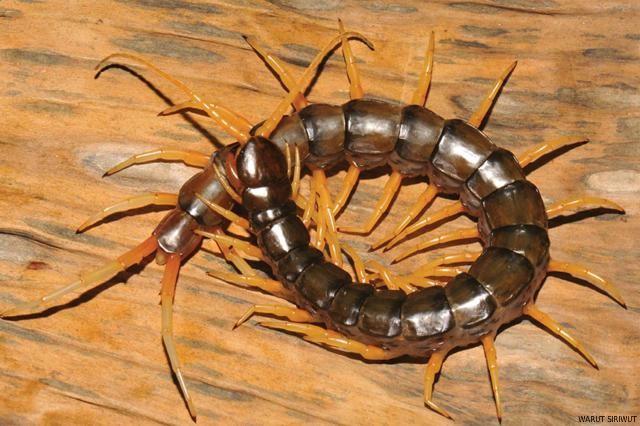Giant swimming centipede discovered in Southeast Asia
Looks like we can add giant amphibious centipedes to the list of things that’ll make you think twice about taking a dip in a river.
World, meet the Scolopendra cataracta, a monster measuring 7.9 inches (20 cm) found in Southeast Asian freshwaters. Scolopendra cataracta, meet world.
The creature, which is carnivorous, venomous, and composed entirely of nightmares, is the first known centipede capable of living both in water and on land. It belongs to the Scolopendra group of centipede behemoths. It is described in extensive detail in a recent entry in the ZooKeys journal.

A honeymoon surprise
We can thank the cherubic Cupid for the centipede’s discovery.
In 2001, George Beccaloni, curator of London’s Natural History Museum (NHM), was honeymooning with his bride in Thailand. Like any good scientist, he used the romantic getaway as an opportunity to look for his favorite things – which in this case is bugs.
“Wherever I go in the world, I always turn over rocks beside streams, and that’s where I found this centipede, which was quite a surprise,” explained Beccaloni.
Its cover gone, the startled centipede skittered away from Beccaloni. But instead of disappearing into the woods, it escaped into the water, making its way along the riverbed until it found another rock to hide under.
“It was pretty horrific-looking: very big with long legs and a horrible dark, greenish-black color,” he said.
Others would have already fled the scene as if the hounds of hell were nipping at their heels, but Beccaloni persisted with his pursuit until he captured the critter. Then, he deposited it in a container filled with water. As it swam to the bottom, it undulated its body horizontally, which is similar to how eels move around.
Beccaloni returned to London and presented the centipede to the NHM. But the expert who examined it found his story hard to believe, as Scolopendra are typically not amphibians, preferring to live in dry regions. Therefore, though the specimen was added to the museum’s collection, it wasn’t considered an extraordinary find… until many years later.
A special kind of monster
The NHM’s Gregory Edgecombe, and his Thai student Warut Siriwut, were in the possession of two centipede specimens, which they had gathered from Laos, specifically from areas near waterfalls. After studying the creatures’ DNA, the scientists confirmed they had a new centipede species in their hands. They named it Scolopendra cataracta. “Cataractra” is Latin for “waterfall.”
Beccaloni discussed his previous discovery with Edgecombe, which proved that the specimen caught all those years ago in Thailand is in fact a Scolopendra cataracta.
As of writing, scientists have only four Scolopendra cataracta specimens: the one found in Thailand, the two in Laos, and a fourth, which, in 1928, was taken from its habitat in Vietnam, but was thought to belong to an ordinary centipede species.
The scientists are already forming theories about the animal.
“Other Scolopendra hunt on land,” stated Beccaloni. “I would bet this species goes into the water at night to hunt aquatic or amphibious invertebrates.”
The Scolopendra cataracta’s venom isn’t fatal to humans, but it will most probably really, really hurt.
“All large Scolopendra can deliver a painful bite, the ‘fang’ of the venom-delivery system being able to pierce our skin,” explained Edgecombe.
The pain is akin to a burning sensation – one that can affect an entire limb, even if the centipede bites only the toe or finger. Edgecombe doubts any permanent damage can arise from such a venomous bite, although it is likely to last a couple of days.
Beccaloni and Edgecombe are understandably happy about this new discovery. They are, however, more excited about the fact that the natural world still has so many mysterious left to unravel.
“People tend to study streams in the tropics during the day, but there is probably a whole other range of interesting amphibious things that come out at night,” stated Beccaloni. “It would be good to study these streams and their fauna then to see what is actually going on under the cover of darkness.”
As for the Scolopendra themselves, the freaks of nature continue to surprise and horrify. In 2014, a centipede was discovered that had eaten its way out of a snake, bursting out of the reptile’s belly like the Xenomorph from the Alien moves. Stories like this, however, aren’t enough to stop some brave individuals from keeping them as pets.
The Scolopendra are found in temperate climates around the world, including yes, the Philippines. More reason to stay indoors! — TJD, GMA News




